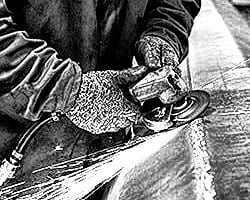Troubleshooting Tips for Grinding Metal
By Andy Shumate, district sales manager, Weiler Abrasives
Metal grinding is a key step in the process of many welding and fabricating operations, but oftentimes operators don’t receive proper training in grinding best practices or troubleshooting.
Problems in the grinding operation can result in costly downtime, potentially holding up project timelines or slowing the movement of parts out the door. Training helps operators avoid problems and solve them faster when they do arise.
Learn about six common problems — from chatter to wheel loading — that occur in metal grinding and get tips for how to solve them quickly.
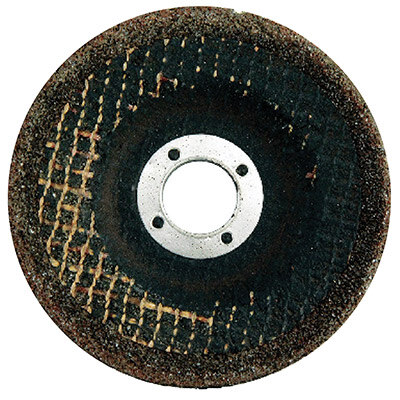 Issue 1: Uneven wear
Issue 1: Uneven wear
This is a common problem that is typically easy to correct. In many general grinding operations, uneven wheel wear is caused by excessive pressure on the tool, uneven pressure, a low grinding angle, or a combination of the three.
Walk through these troubleshooting steps to discover what might be causing uneven wear or uneven edge wear:
- When mounting the wheel on the grinder, be sure the adapting nuts are mounted correctly and that the wheel is properly tightened to the tool. Tighten the nut just enough to keep the wheel from slipping but avoid overtightening, which can damage the wheel.
- Be sure the workpiece is tightly and securely clamped.
- Before grinding the base metal, run the grinder freely for a short period of time to check for flutter or excessive vibration, which can be a sign of an out-of-balance wheel or poor installation.
- For uneven edge wear specifically, reduce the pressure being used while grinding and be sure to keep the angle of the tool to the workpiece at 25 to 30 degrees.
The goal should be to use the minimum pressure necessary to keep the work in motion evenly across the face of the wheel.
Issue 2: Cracked wheels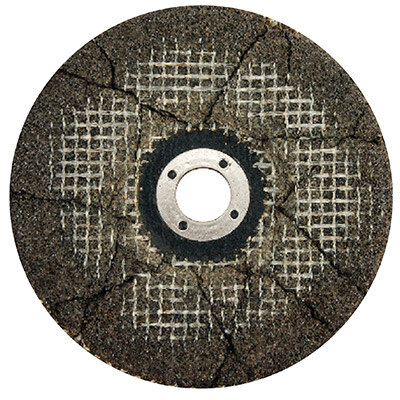
Using a product that is too hard for the application can be a cause of grinding-wheel cracking. The hardness of bond in a grinding wheel determines its grade, which can have a significant impact on control, cut-rate, and life of the wheel.
In general, when choosing a grinding wheel use a softer or weaker bond when grinding harder materials and use a harder bond when grinding softer materials like aluminum. A move of just one or two hardness grades can have a dramatic effect on the process. Hardness grades are typically linear. Moving just one letter grade — from an R-grade wheel to an S-grade wheel, for example, can double the wheel life.
Be aware that the hardness rating of grinding wheels varies by manufacturer, and there’s no standardized system to measure hardness across brands, making it difficult to compare one grinding wheel manufacturer’s wheel hardness to another manufacturer’s wheel hardness. Consult with your local distributor or the manufacturer’s representative to get more information about choosing the proper hardness for the job.
Grinding at a low angle can be another cause of wheel cracking. If your grinding wheel is skipping or chattering on the workpiece, try grinding at an increased (steeper) angle between 25 to 35 degrees to see if that eliminates the issue.
If a grinding wheel is dropped or damaged prior to or during use, replace it immediately.
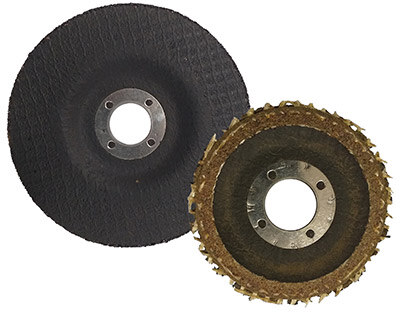 Issue 3: Shortened wheel life
Issue 3: Shortened wheel life
Numerous factors can contribute to shortened wheel life, including using a wheel bond that is too soft, using excessive pressure, or grinding at an angle that is too steep.
Grinding wheel hardness and grit can be factors in wheel life. Consider using a harder product that will last longer and reduce pressure while using the wheel. The goal is to use the minimum pressure necessary to keep the work in motion evenly across the face of the wheel. Let the tool and the wheel do the work as they are designed to do.
Using an underpowered tool or an extension cord with the wrong wire gauge or length can also contribute to shortened wheel life. It’s recommended to use a higher-powered tool and a 10-gauge or 12-gauge extension cord to ensure maximum power from your tool.
There are two key factors in choosing the right extension cord: wire gauge and cord length. The thicker the copper wire, the more electricity, or power, the cord can carry.
Regarding cord length, power diminishes over the distance it travels. The longer the length of the extension cord, the more critical it is to use a wire gauge that ensures maximum current is being delivered to the tool.
Issue 4: Wheel chatter
Chatter, or wheel vibration, is a common problem in grinding. This problem can be grouped into two categories: forced chatter and unforced chatter.
Forced chatter is commonly caused by an out-of-balance wheel, a bad bearing in the grinder, uneven wear on the grinding wheel, an improperly mounted wheel, or improper clamping of the base material, which allows vibration.
Unforced chatter will grow over time. Most of the time the cause for this is the dulling of the wheel or an ineffective or too-shallow grinding angle.
To resolve wheel chatter, clean or replace adapting nuts that may be dirty or worn. Check to be sure that the wheel is mounted flush and even with the adapting nut and that there are no uneven gaps where the wheel sits on the lower adapting nut. Also, replace your grinder or have it professionally repaired if it is determined to have worn-out bearings. You can check the bearings by freely running the grinder with the wheel installed for a short period of time prior to starting work. In many cases, operators can hear a knocking noise if there is a bad bearing.
If you go through all of these troubleshooting steps and there is still wheel chatter, adjust the grinding angle. Avoid using very shallow or flat grinding angles, especially on harder material, which can cause the wheel to chatter, limiting its ability to cut.
Issue 5: Wheel loading
When an abrasive product becomes clogged or gummed up due to material filling the spaces between the abrasive grit, this is referred to as loading. It’s easy to see when this happens on a grinding wheel. Operators will also be able to feel when a wheel loads, as grinding becomes ineffective.
Loading happens more frequently when grinding softer and non-ferrous alloys or those that have a lower melting temperature, such as aluminum. If you’re not using a grinding wheel made for working with aluminum, it doesn’t take long for loading to occur.
To avoid wheel loading when grinding softer metals, look for a product designed specifically for grinding non-ferrous metals and alloys. These products are designed to resist loading.
Issue 6: Wheel doesn’t grind
There are many factors that can keep a wheel from grinding. Some common causes are using a product bond that’s too hard for the base material, using inadequate pressure while grinding, or using an underpowered tool.
Consider using a softer product and increasing pressure during grinding. In addition, be sure to use a higher-powered tool to ensure maximum performance from your wheel. Also, choose an extension cord that is capable of delivering enough power to the grinder. An underrated extension cord “chokes” power to the motor, limiting wheel performance.
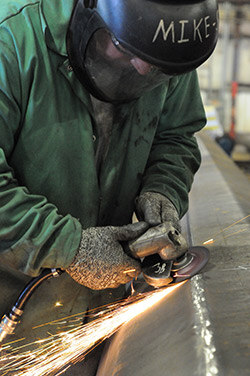 Addressing problems in metal grinding
Addressing problems in metal grinding
Whether the application is construction, shipbuilding, or general metal fabrication, choosing the right grinding wheel for the material and the needs of the job are key to getting the best result when grinding metal.
It’s also important to understand the proper use of each type of wheel and tips for troubleshooting common problems. In many cases, using the right wheel combined with the proper technique and pressure can eliminate many issues operators face when grinding — saving time and money in the operation.
Contact Information: [email protected]
Andy Shumate, District Sales Manager

Need Support? - Contact Us
Resources
ARTICLE: Guide to Grinding Wheels
ARTICLE: Pro Secrets for Maximizing Grinding Performance and Efficiency
